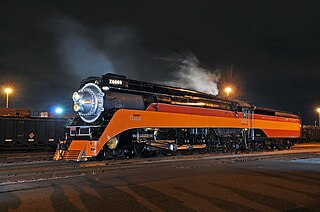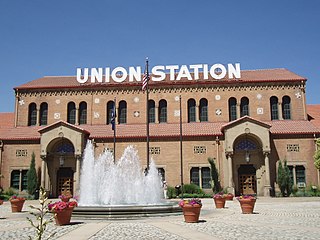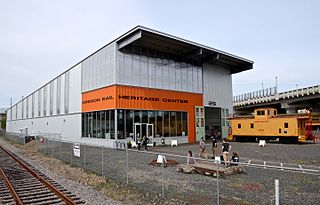
The Union Pacific Railroad, legally Union Pacific Railroad Company and simply Union Pacific, is a freight-hauling railroad that operates 8,300 locomotives over 32,200 miles (51,800 km) routes in 23 U.S. states west of Chicago and New Orleans. Union Pacific is the second largest railroad in the United States after BNSF. Union Pacific and BNSF Railway have a duopoly on transcontinental freight rail lines in the western United States.

The Amtrak Cascades is a passenger train corridor in the Pacific Northwest, operated by Amtrak in partnership with the U.S. states of Washington and Oregon. It is named after the Cascade mountain range that the route parallels. The 467-mile (752 km) corridor runs from Vancouver, British Columbia, through Seattle, Washington and Portland, Oregon to Eugene, Oregon.

The Coast Starlight is a passenger train operated by Amtrak on the West Coast of the United States between Seattle and Los Angeles via Portland and the San Francisco Bay Area. The train, which has operated continuously since Amtrak's formation in 1971, was the first to offer direct service between Seattle and Los Angeles. Its name is a combination of two prior Southern Pacific (SP) trains, the Coast Daylight and the Starlight.

The Grand Trunk Western Railroad Company is an American subsidiary of the Canadian National Railway operating in Michigan, Illinois, Indiana, and Ohio. Since a corporate restructuring in 1971, the railroad has been under CN's subsidiary holding company, the Grand Trunk Corporation. Grand Trunk Western's routes are part of CN's Michigan Division. Its primary mainline between Chicago and Port Huron, Michigan serves as a connection between railroad interchanges in Chicago and rail lines in eastern Canada and the Northeastern United States. The railroad's extensive trackage in Detroit and across southern Michigan has made it an essential link for the automotive industry as a hauler of parts and automobiles from manufacturing plants.

A rail yard, railway yard, or railroad yard is a complex series of railroad tracks for storing, sorting, or loading and unloading railroad cars and locomotives. Railroad yards have many tracks in parallel for keeping rolling stock or unused locomotives stored off the mainline, so that they do not obstruct the flow of traffic. Railroad cars are moved around by specially designed yard switchers, a type of locomotive. Cars in a railroad yard may be sorted by numerous categories, including railway company, loaded or unloaded, destination, car type, or whether they need repairs. Railroad yards are normally built where there is a need to store cars while they are not being loaded or unloaded, or are waiting to be assembled into trains. Large yards may have a tower to control operations.

The Iowa Interstate Railroad is a Class II regional railroad operating in the central United States. The railroad is owned by Railroad Development Corporation of Pittsburgh, Pennsylvania.

The Sumpter Valley Railway, or Sumpter Valley Railroad, is a 3 ft narrow gauge heritage railroad located in Baker County, in the U.S. state of Oregon. Built on a right-of-way used by the original railway of the same name, it carries excursion trains on a roughly 5-mile (8.0 km) route between McEwen and Sumpter. The railroad has two steam locomotives and several other pieces of rolling stock. Passenger excursion trains operate on weekends and holidays from Memorial Day through the end of September.

Southern Pacific 4449, also known as the "Daylight", is the only surviving example of the Southern Pacific Railroad's "GS-4" class of 4-8-4 "Northern" type steam locomotives and one of only two GS-class steam locomotives surviving, the other being "GS-6" 4460 at the Museum of Transportation in St. Louis, Missouri. GS is abbreviation from "Golden State", a nickname for California, or "General Service".

Spokane, Portland & Seattle 700 is the oldest and only surviving example of the class "E-1" 4-8-4 "Northern" type steam locomotive and the only surviving original Spokane, Portland and Seattle steam locomotive. It was built by the Baldwin Locomotive Works in May 1938. Nearly identical to the class "A-3" Northerns built for Northern Pacific Railway, it burns oil instead of coal.

Union Station, also known as Ogden Union Station, is a train station in Ogden, Utah, at the west end of Historic 25th Street, just south of the Ogden Intermodal Transit Center. Formerly the junction of the Union Pacific and Central Pacific Railroads, its name reflects the common appellation of train stations whose tracks and facilities are shared by railway companies.
Rail transportation is an important element of the transportation network in the U.S. state of Oregon. Rail transportation has existed in Oregon in some form since 1855, and the state was a pioneer in development of electric railway systems. While the automobile has displaced many uses of rail in the state, rail remains a key means of moving passengers and freight, both within the state and to points beyond its borders.

The Pacific Northwest Corridor or the Pacific Northwest Rail Corridor (PNWRC) is one of eleven federally designated higher-speed rail corridors in the United States. The 466-mile (750 km) corridor extends from Eugene, Oregon to Vancouver, British Columbia via Portland, Oregon and Seattle, Washington in the Pacific Northwest region. It was designated a high-speed rail corridor on October 20, 1992, as the fifth of five corridors called for in the Intermodal Surface Transportation Efficiency Act of 1991 (ISTEA) although it is now called a higher-speed rail since the minimum speed for a high speed rail is designated as 125 miles per hour (201 km/h). The corridor is owned by BNSF Railway in Washington and British Columbia, and by Union Pacific Railroad (UP) in Oregon, and is used by a mix of freight and passenger trains operated by BNSF, UP, and Amtrak. If improvements to the corridor are completed as proposed in Washington State's long range plan, passenger trains operating at a maximum speed of 110 miles per hour (180 km/h) would travel between Portland and Seattle, in 2 hours and 30 minutes, and between Seattle and Vancouver in 2 hours and 37 minutes by 2023.

The Umatilla Central Railroad built a 14.21-mile (22.87 km) branch line of railroad in Umatilla County, Oregon, U.S., connecting the main line of the Oregon Railroad and Navigation Company (OR&N) at Rieth to Pilot Rock. The company was incorporated on May 24, 1906, and was operated under lease by the OR&N from opening date, December 16, 1907, until December 23, 1910, when the properties of both were sold to new Union Pacific Railroad (UP) subsidiary Oregon–Washington Railroad and Navigation Company. The line has survived as UP's Pilot Rock Industrial Lead.

The Salt Lake, Garfield & Western Railway, nicknamed through most of its history as The Saltair Route, is a short line railroad located in Salt Lake City, Utah. Originally incorporated as a dual passenger and freight railroad, it now provides freight-only railcar switching services to industries in Salt Lake City along its sixteen miles of track.

Hinkle is an unincorporated community along the Umatilla River in northwestern Umatilla County, Oregon, United States. It is south of Hermiston near Interstate 84/U.S. Route 30 and Oregon Route 207, within the Pendleton–Hermiston Micropolitan Statistical Area. It is the site of the Union Pacific Railroad's (UP) Hinkle Locomotive Service and Repair Facility, part of the Hinkle Freight Classification Yard.
The Oregon Rail Heritage Foundation (ORHF) is a registered non-profit organization based in Portland, Oregon, United States. Composed of several all-volunteer groups dedicated to maintaining vintage railroad equipment, the ORHF is committed "to secure a permanent home for the City of Portland’s steam locomotives, preserve the Brooklyn Roundhouse, and establish a Rail and Industrial Heritage Museum.”

The Hood River station is a historic train station in Hood River, Oregon, currently serving the heritage Mount Hood Railroad. The station was listed on the National Register of Historic Places in 1988 as the Oregon–Washington Railroad and Navigation Company Passenger Station. The station was built by the Oregon–Washington Railroad and Navigation Company, a subsidiary of the Union Pacific Railroad, in 1911. Amtrak's Pioneer also used the station and nearby area from 1977–1997.

Rieth is an unincorporated community in Umatilla County, Oregon, United States. It is south of Interstate 84/U.S. Route 30/U.S. Route 395 about 5 miles (8 km) west of Pendleton near the Umatilla River.

The Oregon Rail Heritage Center (ORHC) is a railway museum in Portland, Oregon. Along with other rolling stock, the museum houses three steam locomotives owned by the City of Portland: Southern Pacific 4449, Spokane, Portland & Seattle 700, and Oregon Railroad & Navigation Co. 197, the first two of which are restored and operable. The center opened to the public on September 22, 2012. The project to establish the center was led by the Oregon Rail Heritage Foundation (ORHF), a non-profit organization established in 2002. The museum site is in Southeast Portland.

La Grande station is a train station located in La Grande, Oregon. It was built by the Union Pacific Railroad along its main line to Portland in 1930 and was later used by Amtrak's Pioneer until it was discontinued in 1997. The station building still stands and is listed as a National Register of Historic Places contributing property as the La Grande Railroad Depot, in the La Grande Commercial Historic District.

















